
Top: Photograph from the workshop in October, 2016.
Bottom: Workshop participants, back row, left to right: Uri ten Brink (USGS), Vaughn Barrie (Geological survey Canada), Kim Conway (Geological Survey of Canada), Stu Nishenko (PG&E), Jamie Conrad (USGS), Gary Greene (Moss Landing Marine Lab), and Nathan Miller (USGS); and front row, left to right: Amy East (USGS), Katie Coble (USGS), Tory O'Connell (Sitka Sound Science Center), and Danny Brothers (USGS). [Larger version]
USGS scientists and colleagues held a workshop to share recently acquired marine data on the Queen Charlotte-Fairweather fault in southeast Alaska and to plan 2017 research cruises. Participants from USGS, Geological Survey of Canada, Sitka Sound Science Center, Moss Landing Marine Lab, and Friday Harbor Laboratories met October 25-29, 2016, on Orcas Island, Washington.
Like California’s San Andreas fault, the Queen Charlotte-Fairweather fault (QCFF) is a strike-slip fault separating the Pacific and North American tectonic plates. The QFCC lies mostly offshore southeast Alaska and British Columbia. It has experienced seven major earthquakes in the past 100 years, including a 1949 magnitude-8.1 event, Canada’s largest recorded earthquake.
The workshop participants are collaborating to fill gaps in knowledge about this extremely active fault and the hazards it poses to communities in Alaska and Canada.
Contact: Danny Brothers, dbrothers@usgs.gov, 831-460-7460
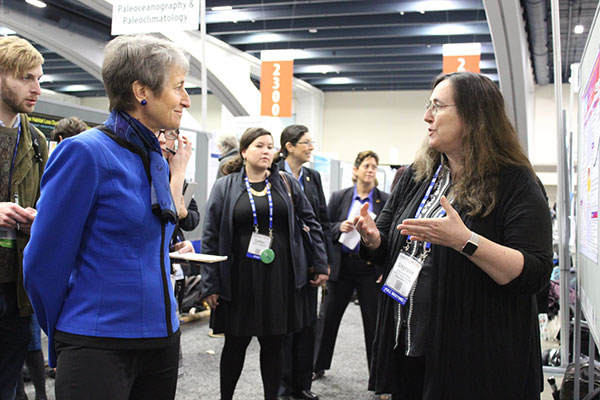
At the 2016 AGU Fall Meeting, USGS geophysicist Stephanie Ross (right) speaks with Interior Secretary Sally Jewell about ways to help decision makers, emergency responders, and other stakeholders use scientific findings about tsunamis. Photo credit: USGS.
A Washington Post article published December 15, 2016, includes a photo of Secretary of the Interior Sally Jewell talking with USGS geophysicist Stephanie Ross at the American Geophysical Union (AGU) Fall Meeting in San Francisco. Ross was showing the Secretary her poster on how to engage decision makers, emergency responders, and other stakeholders in using scientific findings about tsunamis, titled: "Get People Talking: Sharing Tsunami Science Beyond the Web".
View the Washington Post article.
Contact: Stephanie Ross, sross@usgs.gov, 650-329-5326.
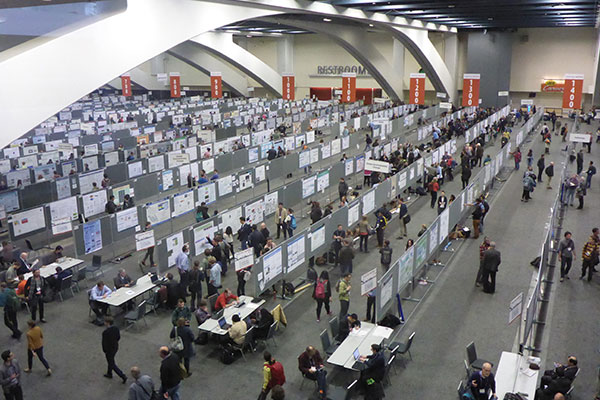
Looking down on the large poster hall at the AGU Fall Meeting. Many rows of posters on boards with people reading and walking. Photo by Rex Sanders, USGS
USGS News Release, Dec. 8, 2016
By Rex Sanders
Their days often start with breakfast meetings and end with working dinners. They give presentations to hundreds of their peers, debate fine points in crowded poster halls, and catch up with colleagues in long refreshment lines.
USGS scientists also broaden their scientific horizons, get ideas for new projects, and plant the seeds for collaborations that might change the way we think about the Earth.
Read the entire USGS News Release.
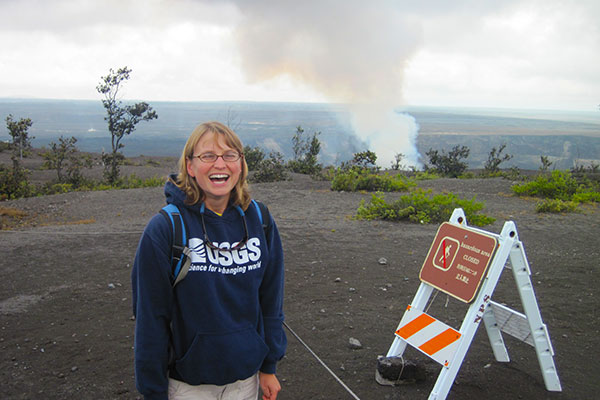
Amy East wears her "I love geology!" face as Hawaiʻi's Kilauea volcano steams in the background. Photo by Erin Todd, USGS.
USGS research geologist Amy East of the Pacific Coastal and Marine Science Center in Santa Cruz, California, spoke October 14, 2016, at an independently organized TED talk event (known as TEDx). East addressed students at Santa Catalina School, an all-girls’ high school in Monterey, about the importance of Earth science and diversity in the sciences. Each year the school’s student-led TEDx team lines up engaging and diverse speakers from the local community. East is one of seven who spoke at this year’s two-hour event. View her talk, “Adventures on Planet Earth,” on the TEDx YouTube channel.
Contact: Amy East, aeast@usgs.gov, 831-460-7533
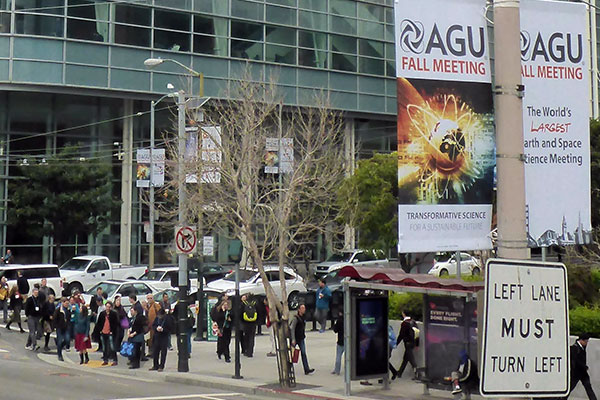 The American Geophysical Union plans to live-stream three 2016 Fall Meeting sessions that include talks by USGS coastal and ocean scientists. AGU On-Demand provides free access to selected sessions via videos live-streamed during the meeting and archived for later viewing. Viewers do not have to be members to sign up. Visit the AGU Fall Meeting web site and click “AGU On-Demand.” The three sessions featuring USGS coastal and ocean science are:
The American Geophysical Union plans to live-stream three 2016 Fall Meeting sessions that include talks by USGS coastal and ocean scientists. AGU On-Demand provides free access to selected sessions via videos live-streamed during the meeting and archived for later viewing. Viewers do not have to be members to sign up. Visit the AGU Fall Meeting web site and click “AGU On-Demand.” The three sessions featuring USGS coastal and ocean science are:
Contact: Rex Sanders, 831-460-7555, rsanders@usgs.gov.
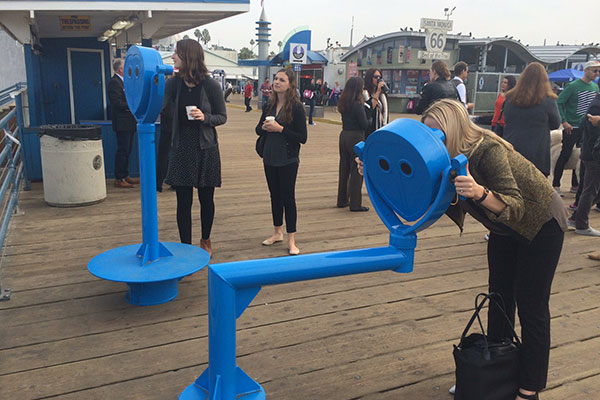
Above: Visitors on Santa Monica Pier look through “Owls,” virtual-reality viewers that show how the beach beside the pier will look when future storms and sea-level rise raise water levels. Photo courtesy of USC Sea Grant.
Below: View through the Owl: At today’s sea level, a big storm together with a high tide could cover almost the entire beach.
See a larger version.

Visitors to the Santa Monica Pier in southern California can now see what the beach might look like when future storms and sea-level rise raise water levels. Two virtual-reality viewers, named “Owls” for their distinctive appearance, show the projected extent of flooding by a big storm at high tide, by sea-level rise, and by both together. The projections come from the USGS Coastal Storm Modeling System (CoSMoS). The viewers also show how communities can adapt to sea-level rise through nature-based coastal-planning projects, such as enhanced dunes. The City of Santa Monica developed the Owls (one ADA-accessible) in partnership with the USGS, Owlized, and the USC Sea Grant program. The Owls will operate from November 7, 2016, to January 7, 2017; a public celebration was held November 16 to coincide with “King” high tides.
View more photographs on our Facebook page (USGS Coastal and Ocean Science)
Contact: Juliette Finzi Hart, jfinzihart@usgs.gov, 424-241-2457.

Screenshot of Janet Watt from CBS This Morning news segment. ©CBS
A camera crew from CBS This Morning visited the USGS Pacific Coastal and Marine Science Center on November 10, 2016, to interview Janet Watt about her discovery of a connection between the Hayward and Rodgers Creek faults, two of the most hazardous earthquake faults in California’s San Francisco Bay area. In addition to a sit-down interview, they filmed Watt and her team—Mary McGann, Katie Maier, and Tom Lorenson—processing sediment cores collected along the fault beneath San Pablo Bay. CBS News correspondent Mireya Villareal asked about what led to the discovery, what it means for Bay Area earthquake hazards, and how the team plans to use microfossils from the cores to date movement on the newly discovered fault strand.
View the segment, which aired November 18.
View b-roll video of USGS scientists and technicians working to collect samples from San Pablo Bay, California.
Contact: Janet Watt, jwatt@usgs.gov, 831-460-7565.
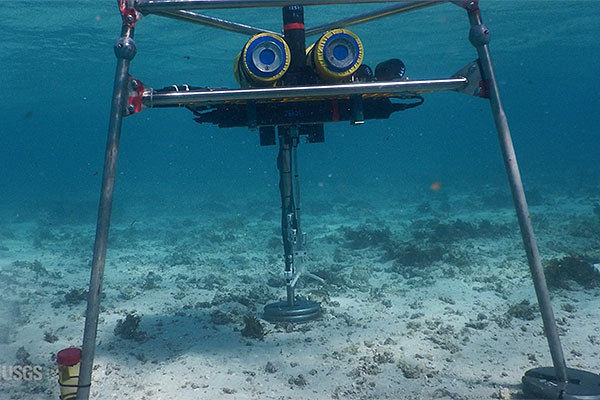
Tripod holding instruments and cameras used to measure and study aspects of sediment movement in and around the reef.
A new video, “Breaking Down Reefs, Building Up Beaches,” follows coral reef experts from the USGS and the University of Western Australia as they conduct the largest-ever hydrodynamic study of how coral reefs shape coasts. The scientists spent two weeks in May 2016 installing instruments to measure currents and sediment movement in and around Australia’s largest fringing reef, in the Ningaloo Coast UNESCO World Heritage Site, Western Australia. Over the next two months, the instruments collected massive amounts of data that will give scientists great insight into the protective role of reefs and will help the USGS forecast what could happen to U.S. fringing reefs in the face of climate change and sea-level rise. View the video. Contact: Curt Storlazzi, cstorlazzi@usgs.gov, 831-460-7521.
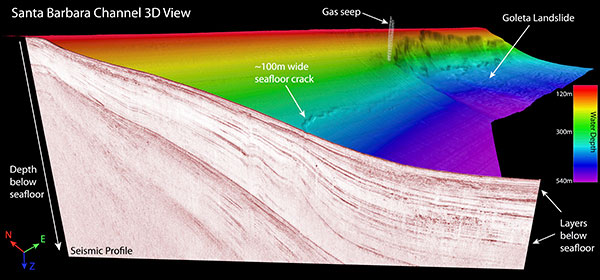
Three-dimensional view of western Santa Barbara Channel. Rainbow colors are seafloor surface, with red for shallowest depths. Cutaway is vertical view (seismic profile) of sediment layers (red lines) beneath the seafloor. Note landslides (far end) and long crack in seafloor. Gas seep location is based on sonar mapping of bubbles in the water column. [Larger version]
From September 11 to October 5, 2016, USGS scientists used high-resolution sonar to map the seafloor and image bubbles from natural gas seeps near Santa Barbara, California. They also collected high-resolution seismic profiles of sub-seafloor sediment layers. They are investigating the causes and history of underwater landslides, which can damage offshore oil platforms and pipelines, and generate local tsunamis. The scientists worked from two research vessels: the R/V Snavely (USGS) and the R/V Shearwater (NOAA Channel Islands National Marine Sanctuary). They will combine the new data with older data to evaluate changes in seafloor topography and to map active faults, old and new landslides, and oil and gas pathways that could weaken slopes and set them up for future slides. The team plans to present preliminary results at the 2016 AGU Fall Meeting in December. Contact: Jared Kluesner, jkluesner@usgs.gov, 831-460-7547.
Learn more on the USGS project page, "Underwater Landslides off Southern California."
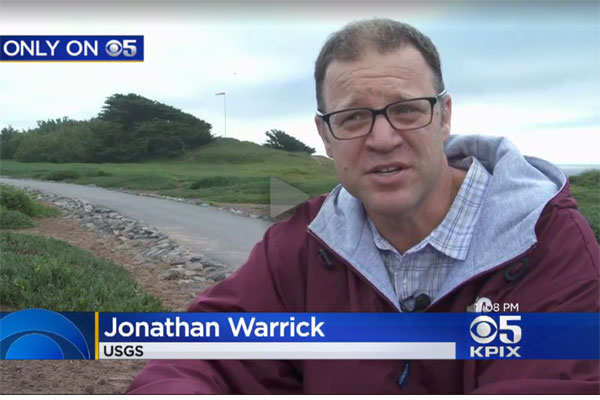
Screen capture of Jon Warrick, from the KPIX story video. © KPIX
USGS geologist Jonathan Warrick appeared in a TV newscast about his use of historical photos to measure cliff erosion at Fort Funston in San Francisco, California. On October 28, 2016, Warrick met Andria Borba of KPIX 5, a CBS affiliate, at Fort Funston. He showed her how easily the cliff crumbles, explained how overlapping photos enabled his team to measure erosion rates, and noted that the results can help scientists forecast future erosion. “Geologists Get 3-D Pictures Of Beach Erosion On California Coast,” aired that night and on the web. A recent press release and journal article by Warrick and others prompted the interview. Contact: Jon Warrick, jwarrick@usgs.gov, 831-460-7569.

On research vessel Retriever (right), USGS scientists led by Janet Watt (left) collected core samples of bayfloor sediment along the Hayward-Rodgers Creek fault zone in San Pablo Bay, California, to investigate the history of faulting beneath the bay.
From October 17-21, 2016, USGS scientists collected 20 core samples of bayfloor sediment along the Hayward-Rodgers Creek fault zone in San Pablo Bay, a northern extension of San Francisco Bay, California. The longest core measures nearly 4 meters. Detailed radiocarbon dating of benthic forams (one-celled microorganisms) in the core samples will aid in unraveling the history of faulting in the bay and constraining the age of the most recent surface-rupturing earthquake along this part of the fault zone. Recent high-resolution acoustic imaging revealed a direct link between the Hayward and Rodgers Creek faults and provided a framework for targeted sampling of offset sediment layers, unconformities, and peculiar gas pockets. Contact: Janet Watt, jwatt@usgs.gov, 831-460-7565.
Research oceanographer Curt Storlazzi (Pacific Coastal and Marine Science Center) served as a shallow-water coral expert in a panel discussion titled “Understanding Coral Reefs through Marine Science and Woolly Sculptures.” The free public event took place October 20, 2016, at the Seymour Marine Discovery Center, affiliated with the University of California, Santa Cruz (UCSC). Storlazzi was joined by deep-sea coral expert Matt McCarthy of UCSC and science communicator Margaret Wertheim. Wertheim’s projects include Crochet Coral Reef, the largest participatory art/science project in the world. The panel explored the interweaving of science and art, with a focus on coral reefs and the challenges that sea-level rise, climate change, and human-driven stressors pose to their health and sustainability. Contact: Curt Storlazzi, cstorlazzi@usgs.gov, 831-460-7521.
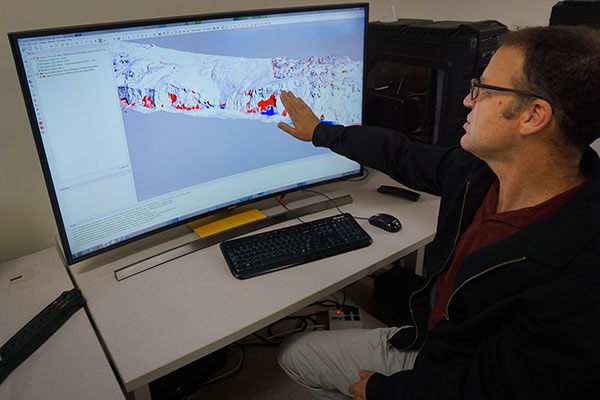
USGS research geologist Jon Warrick explains a “difference map” constructed from structure-from-motion data. Red areas indicate loss of material (erosion); blue areas show addition of material (deposition). Photo by Amy West, USGS
U.S. Geological Survey scientists and their coauthors from the California Coastal Records Project have found a way to use historical aerial photographs to accurately measure coastal erosion. Applying a low-cost technique called “structure-from-motion” to five sets of oblique aerial photos spanning the years 2002 to 2010, the scientists measured the volume of material eroded from coastal cliffs at Fort Funston, on the westernmost edge of San Francisco. Their results were published October 21, 2016 in the Journal of Coastal Research. Quantifying coastal change is essential for calculating trends in erosion, evaluating processes that shape coastal landscapes, and predicting how the coast will respond to future storms and sea-level rise, all critical for communities along the California coast.
To learn more, read the USGS news release or contact Jon Warrick, jwarrick@usgs.gov, 831-460-7569. Also, watch Jon's interview which aired on CBS SF Bay Area, October 28th.
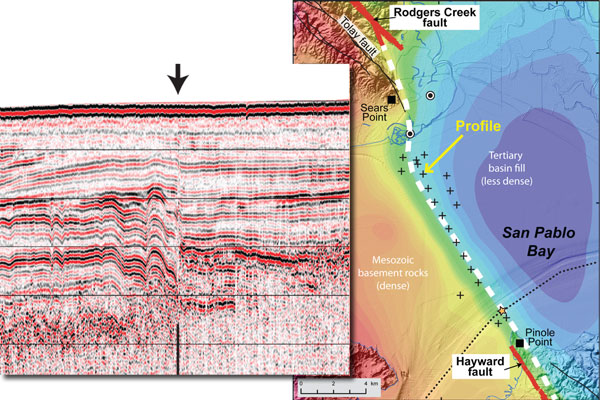
Above, left: Seismic-reflection profile created by bouncing sound waves off sediment layers beneath San Pablo Bay. Note deformation of layers by Hayward fault (black arrow). Above, right: Variations in gravity caused by differences in rock density under the bay. Sharp change in gravity values (dashed white line) lies close to sites where seismic-reflection profiles imaged the Hayward fault (plus signs).
USGS scientists used a suite of complementary techniques to image sediment layers beneath San Pablo Bay, California, revealing an active fault beneath the bay that links two of the most urbanized and hazardous strike-slip faults in the San Francisco Bay area. The discovery, first announced December 2015 at the American Geophysical Union Fall Meeting, is detailed in “Missing Link between the Hayward and Rodgers Creek Faults,” published October 19, 2016, in Science Advances. Longer fault ruptures produce larger earthquakes, so understanding how fault segments connect with one another is critical to assessing the earthquake hazards they pose. This study demonstrates the importance of integrated, high-resolution mapping of sub-seafloor layers for characterizing the often-subtle deformations (as small as a few centimeters) where fault segments meet. Contact: Janet Watt, jwatt@usgs.gov, 831-460-7565.
Learn more about the USGS study, "Offshore Faults along Central and Northern California"

USGS geologist Amy East was delighted to observe a Chinook salmon carcass upstream from two dams recently removed from the Elwha River in Washington State. River restoration has allowed salmon to reach upstream spawning grounds for the first time in more than a century.
For the first time in more than a century, salmon have reached stretches of the Elwha River upstream from two dams built in the early 1900s and recently removed. In August 2016, fisheries biologists observed live salmon there. In September 2016, USGS scientists doing topographic surveys found carcasses of Chinook salmon that died after migrating from the ocean to above the upper dam site, completing their natural life cycle. Although dam removal concluded in 2014, a boulder jam remained a fish barrier until fall 2015, when NPS dynamited the boulders. Now, fish are migrating into the upper watershed—a huge success for the Elwha River Restoration Project, recently honored as a finalist for the international Riverprize. Monitoring ecosystem recovery in the Elwha is a cooperative effort by Olympic National Park, Lower Elwha Klallam Tribe, U.S. Fish and Wildlife Service, USGS, NOAA, and Washington Department of Fish and Wildlife. Contact: Amy East, aeast@usgs.gov.
Learn more about USGS science supporting the Elwha River Restoration Project.

Melissa Foley (right) and colleagues preparing for the “Planning for Cumulative Effects in a Complex World” workshop, held 17 August 2016 in Wellington, New Zealand.
USGS research ecologist Melissa Foley served as an international science expert at the “Planning for Cumulative Effects in a Complex World” workshop held 17 August 2016 in Wellington, New Zealand. Cumulative effects are environmental stressors that overlap in space and/or time. Coastal and marine examples include sea-level rise, fishing, coastal development, and ocean acidification. Foley helped plan and execute the workshop, where participants discussed the challenges of assessing cumulative effects in coastal and marine systems, and ways to facilitate communication among scientists, funding agencies, and policy makers. Foley’s USGS research focuses on understanding how systems are connected, how human and natural disturbances affect those connections, and how science can be integrated with management strategies to address coastal and marine issues. Contact: Melissa Foley, mfoley@usgs.gov, 831-460-7564.
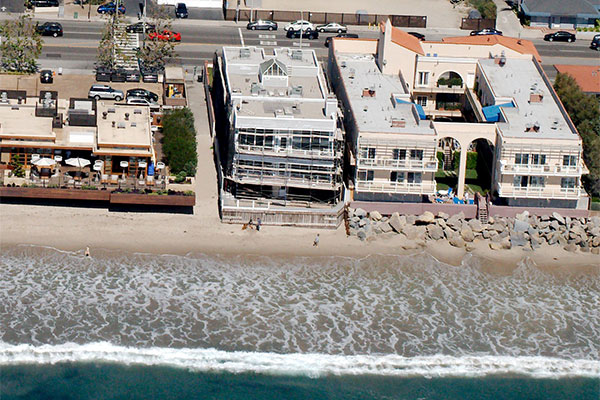
Stretch of beach in Malibu, California, vulnerable to flooding from storms and sea-level rise. Cropped from image 201309712 in California Coastal Records Project.
USGS science turned up in an unexpected place: The Hollywood Reporter, which ran the story “Underwater in 40 Years? Which L.A. Beach Homes Are at Risk” in its August 12, 2016, issue. The piece describes how projected sea-level rise could inundate expensive areas and homes, and how flooding could be higher during a major winter storm. The reporter relied on data and maps from the USGS Coastal Storm Modeling System (CoSMoS). CoSMoS makes detailed long-range forecasts of coastal erosion and flooding caused by climate change, sea-level rise, and storms. Several California agencies used preliminary results from a CoSMoS update to plan for possible storm flooding and erosion during last year’s El Niño. Contact: Patrick Barnard, pbarnard@usgs.gov, 831-460-7556.
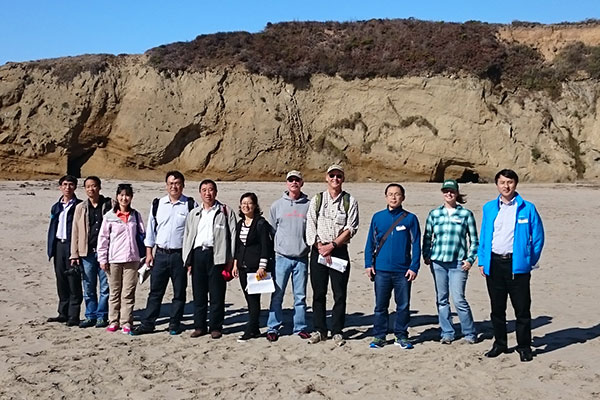
Chinese visitors and USGS hosts during a field trip stop at Cove Beach in Año Nuevo State Park. Photo by Stephen Hartwell, USGS.
Eight scientists from the China Geological Survey (CGS) and affiliated organizations visited the USGS Pacific Coastal and Marine Science Center in Santa Cruz, California, on September 14 and 15, 2016. The Chinese visitors and their USGS hosts discussed their respective coastal research programs and possibilities for future cooperation. During a one-day workshop on September 14, scientists from both groups described research to address various coastal issues, including flooding, erosion, seafloor habitats, sediment movement, offshore earthquakes, and wetland loss. On September 15, the visitors learned more about USGS studies during a field trip to coastal areas north and south of Santa Cruz. Ms. Ping Yin, professor at Qingdao Institute of Marine Geology and coordinator of a new CGS coastal geology program, initiated the visit to further cooperation between CGS and USGS scientists. Contact: Bob Rosenbauer, brosenbauer@usgs.gov, 831-460-7401.
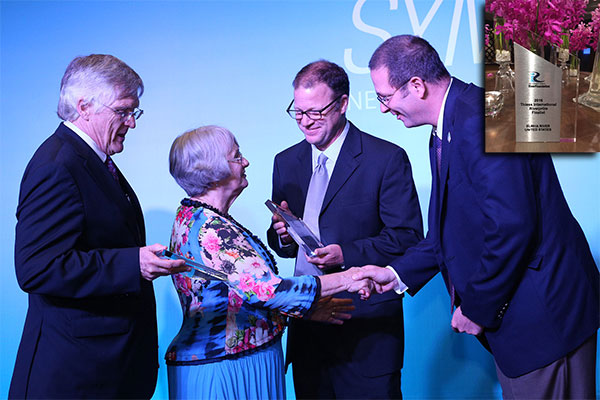
USGS scientists Jonathan Warrick and Jeff Duda receiving Riverprize recognition in New Delhi, India. Inset: Plaque recognizing the Elwha River Restoration Project as one of three finalists for the 2016 Thiess International Riverprize. Images courtesy of International Riverfoundation. [Larger version]
Collaborative work by the U.S. Department of the Interior and the Lower Elwha Klallam Tribe to restore the Elwha River of Washington, USA, was honored during the awarding of the 2016 Thiess International Riverprize. The International RiverFoundation awards the Riverprize annually to support premier examples of river-restoration management. Research geologist Jonathan Warrick (USGS Pacific Coastal and Marine Science Center) and research ecologist Jeff Duda (USGS Western Fisheries Research Center) represented DOI at the 2016 awards ceremony, held September 14 at the 19th International River Symposium in New Delhi, India. The Elwha River Restoration Project was recognized for its unprecedented approach to restoring salmon populations and other ecosystem elements through the largest dam removal project in history. The three finalists were the Segura River of Spain, and the Niagara and Elwha Rivers of the USA. The Buffalo Niagara Riverkeeper project won the Riverprize.
For more information, read the USGS News Release, or contact Jonathan Warrick, jwarrick@usgs.gov, 831-460-7569.
Visit the USGS Science to Support the Elwha River Restoration Project web site.

Left to right: Curt Storlazzi, Peter Swarzenski, and Christina Kellogg during a 2015 survey of the field area in Kauai, to which Storlazzi and Kellogg returned for more concentrated work in summer 2016. Photo by Amy West, USGS. [Larger version]
Newspaper and radio reporters in Kauai, Hawaiʻi, interviewed USGS researchers on possible causes of a black band coral disease outbreak on the island’s north shore. In an article in the Garden Island newspaper, research geologist Curt Storlazzi of the Pacific Coastal and Marine Science Center explained that fresh groundwater entering the ocean from seafloor seeps could stress nearby corals. He led a USGS team July 29–August 5 to gather evidence for submarine groundwater discharge, collect water samples to test for nutrients and contaminants, and measure currents to determine how they might concentrate or disperse groundwater after it enters the ocean. Storlazzi’s collaborator Chris Kellogg, research microbiologist with the St. Petersburg Coastal and Marine Science Center, spoke about the black band work on Hawaii Public Radio. Contact: Curt Storlazzi, cstorlazzi@usgs.gov, 831-460-7521.
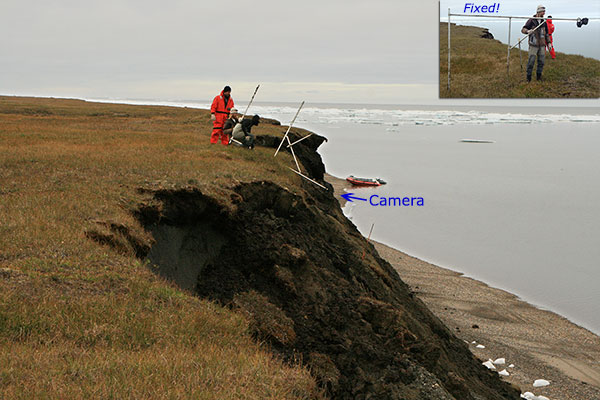
Craig Crutchfield (Office of Budget and Management, left), Will Wiese (Arctic refuge biologist, Fish and Wildlife Service), and Arctic Refuge volunteer Justine Heseltine recover a USGS erosion-monitoring camera west of Kaktovik. [Larger version]
Brian Glaspell, refuge manager of the Arctic National Wildlife Refuge (U.S. Fish and Wildlife Service), requested information about USGS work on Barter Island, Alaska, from scientists at the Pacific Coastal and Marine Science Center (PCMSC). In early August, Glaspell led members from the Department of the Interior and the Office of Management and Budget around the village of Kaktovik to discuss coastal erosion in the Arctic and building resilience in rural Alaskan communities. During the land and sea tour, the group saw chunks of ice and earth collapsing from coastal bluffs and recovered a fallen USGS time-lapse camera. Just a year before with Glaspell on Barter Island, USGS PCMSC scientist Bruce Richmond described the science of coastal erosion along the North Slope to U.S. Senators Tim Kaine (VA) and Martin Heinrich (NM), along with FWS Director Dan Ashe.
Contact: Bruce Richmond brichmond@usgs.gov, 831-460-7531.
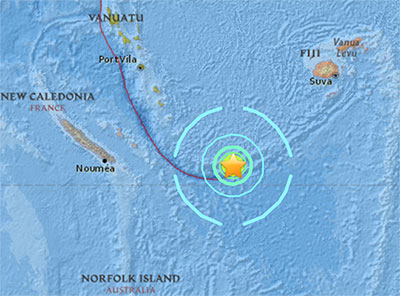
Epicenter (star) of magnitude 7.2 earthquake that generated a small tsunami in the southwest Pacific Ocean on August 12, 2016. Learn more.
Rowena Lindsay of the Christian Science Monitor interviewed research geophysicist Eric Geist of the Pacific Coastal and Marine Science Center on Friday, August 12, about a magnitude 7.2 earthquake that generated a small tsunami when it hit the Pacific Ocean near New Caledonia the previous day. Her article, posted August 12, quotes Geist explaining how undersea earthquakes produce tsunamis. He also observed that the tsunami was larger than expected for a strike-slip earthquake of magnitude 7.2 and noted that a quake-triggered landslide or movement of a steep slope might explain the tsunami's size. Contact: Eric Geist, egeist@usgs.gov, 650-329-5457.
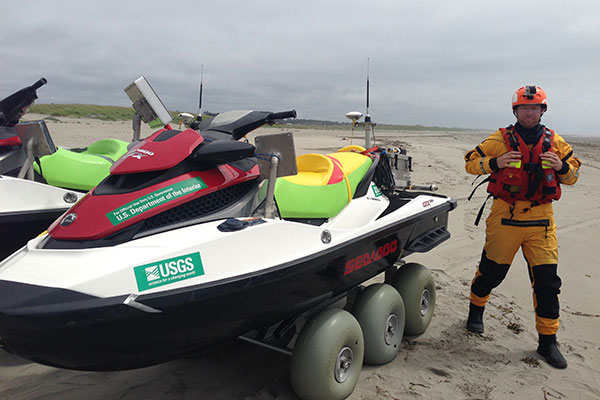
Tim Elfers (USGS) preparing to launch a personal watercraft equipped with GPS and sonar for mapping the bottom close to shore. Photograph by Andrew Stevens, USGS. [Larger version]
In the last two weeks of August 2016, USGS scientists from the Pacific Coastal and Marine Science Center will collect bathymetric (seafloor depth) and topographic (land elevation) data from Washington and Oregon beaches near the mouth of the Columbia River. The data will help them document the effect of the recent El Niño on Pacific Northwest beaches as well as monitor long-term coastal changes. One goal of monitoring is to determine whether sediment dredged from the river's navigation channel and placed on the seabed is helping to counter beach and jetty erosion. The USGS is working closely with the states of Washington and Oregon, the U.S. Army Corps of Engineers, and Oregon State University to provide decision makers with the best available scientific information on sediment management.
Contact: Guy Gelfenbaum, ggelfenbaum@usgs.gov, 831-460-7417.
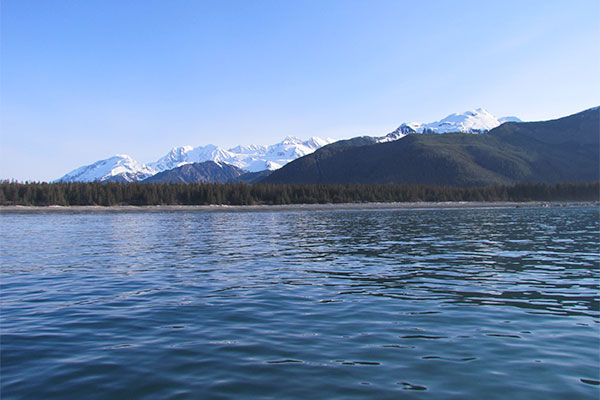
View north toward the Fairweather Range during 2015 mapping of the Queen Charlotte-Fairweather fault off Glacier Bay National Park and Preserve. The fault is directly beneath the vessel. Fieldwork in 2016 will extend mapping southeast to near the U.S.-Canada border. Photo by Danny Brothers, USGS. [Larger version]
Scientists from the Pacific Coastal and Marine Science Center are mapping shallow sediment layers along the Queen Charlotte-Fairweather fault offshore southeast Alaska from August 8-24 (see more details on the Field Activity page). The seaward side of this major earthquake fault moves northwest relative to the landward side at an average rate of about 2 inches per year. This fast slip rate provides a rare opportunity to document deformation caused by individual earthquakes, and examine fault evolution in areas that have generated large historical earthquakes. In May and June, USGS scientists mapped approximately 200 miles of the seafloor along the fault for the first time. They used data from that survey to choose targets for the current survey.
Contact: Danny Brothers, dbrothers@usgs.gov; or Bob Rosenbauer, brosenbauer@usgs.gov, 831-460-7401.
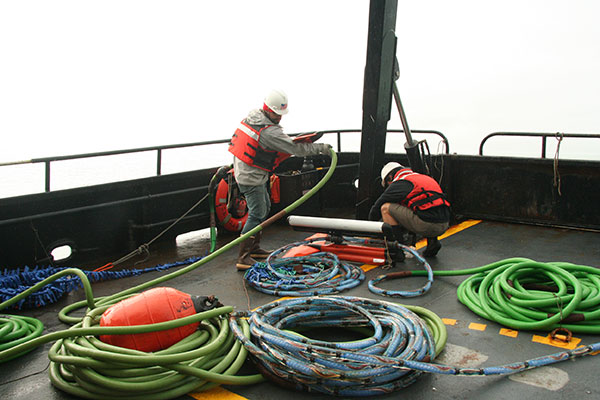
Dan Ebuna (University of California, Santa Cruz; left) and Jackson Currie (USGS) work on research vessel Norseman amid thick fog on Resurrection Bay. They are preparing equipment that will be towed behind the vessel to image sediment layers beneath the seafloor. [Larger version]
Scientists from the Pacific Coastal and Marine Science Center were testing equipment in Resurrection Bay, Alaska, on August 8 when their research vessel received a distress signal from a small boat about 3 miles away. The privately owned R/V Norseman steamed to the location and found three people stranded on a rocky beach after capsizing a skiff in the surf. Three Norseman crewmembers deployed a rubber raft to rescue the boaters. Due to the large swells, one of the crew swam to the beach and pulled the victims to the raft one by one in survival suits. Soon the boaters were aboard Norseman, wrapped in blankets and drinking hot coffee. After dropping the boaters off in Seward, the scientists departed for their two-week cruise to map a major earthquake fault off southeast Alaska. Learn more about the USGS research cruise.
Contact: Danny Brothers, dbrothers@usgs.gov; or Bob Rosenbauer, brosenbauer@usgs.gov, 831-460-7401.
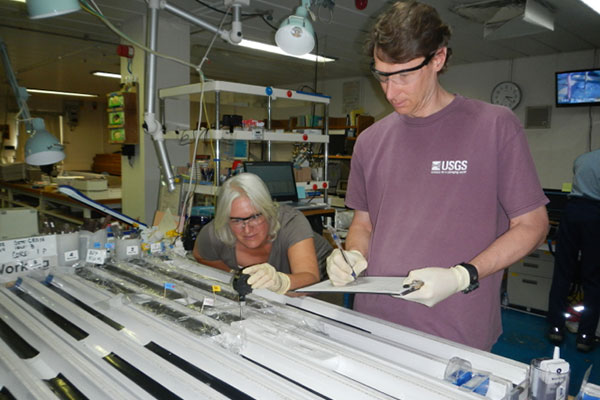
USGS Scientists Dr. Pamela Swarzenski (left) and Dr. William Waite making measurements on sediment cores recovered from Indian Ocean during the National Gas Hydrate Program Expedition 02.
USGS scientists from the Central Energy Resources Science Center, the Woods Hole Science Center, and the Pacific Coastal and Marine Science Center assisted the Government of India in the discovery of large, highly enriched accumulations of natural gas hydrate in the Bay of Bengal. This is the first discovery of its kind in the Indian Ocean that has the potential to be producible. Natural gas hydrates are a naturally occurring, ice-like combination of natural gas and water found in the world’s oceans and polar regions. The amount of gas within the world’s gas hydrate accumulations is estimated to greatly exceed the volume of all known conventional gas resources. Contact: Bob Rosenbauer, brosenbauer@usgs.gov, 831-460-7401.
Read the entire USGS news release.
Also, read the USGS Energy Resources Program's news page on "Results of the India National Gas Hydrate Program Expedition 02."
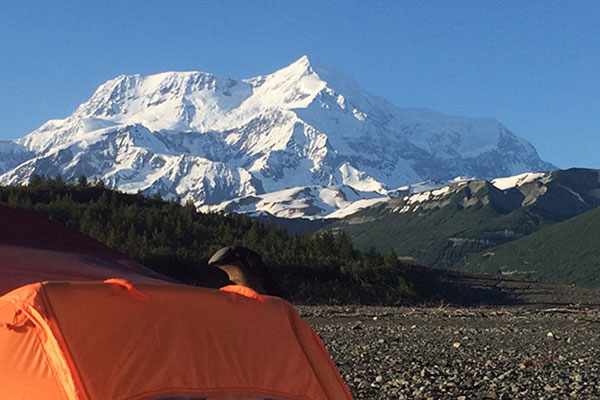
In Icy Bay, Alaska, photograph of Taan Fiord base camp near sea level with the 18,000' Mt. St. Elias in the background. The tent is pitched on one to two meters of 8-month-old tsunami deposits. Much of the barren landscape was former forest.
Southeast Alaska’s 18,000-foot Mount Saint Elias rises behind a USGS tent pitched on sandy gravel left by a tsunami 8 months ago. On October 17, 2015, a rain-soaked mountainside slid into Taan Fiord on Icy Bay, sending a giant wave more than 500 feet up the opposite slope. Large tracts of barren landscape along the fiord margins used to be forest. USGS scientists study recent tsunami deposits to better understand how tsunamis work, recognize ancient tsunami deposits, and improve natural-hazard assessments.
For more information, contact Bruce Richmond, brichmond@usgs.gov, 831-460-7407.

Conceptual drawing of bottom trawling from a fishing boat, showing a net and metal plate being dragged along the seafloor behind a boat on the surface. Image credit: Ferdinand Oberle, 2014.
Recent research outlines the severe consequences that bottom trawling has on loose sediment on the ocean floor. Bottom trawling is a widespread industrial fishing practice that involves dragging heavy nets, large metal doors, and chains over the seafloor to catch fish. Although previous studies have documented the direct impacts of bottom trawling on corals, sponges, fishes, and other animals, an understanding of the global impact of this practice on the seabed remained unclear until now. The first calculation of how much of the seabed is resuspended (or stirred up) by bottom-trawling shows that the sediment mass is approximately the same as the amount of all sediment being deposited on the world’s continental shelves by rivers each year (almost 22 gigatons).
Read the entire Sound Waves newsletter article.

Aerial view (taken by a drone) of the USGS team sampling seawater for carbonate chemistry along the reef of Kāʻanapali, west Maui. Clockwise from left: Nate Smiley, St. Petersburg, Chris Gallagher and Nancy Prouty, Santa Cruz, and Kim Yates, St. Pete. Photo courtesy of a passerby.
USGS scientists focused on understanding the link between land-based pollutants and coral reef health along the coast of west Maui in the Hawaiian Islands. Many reefs in this area are being overgrown by invasive seaweeds, a concern since the late 1980s. The algal growth has been linked to pollutants from the land, including elevated levels of nutrients—such as nitrogen and phosphorus—in water from wastewater injection wells. This nutrient-rich water enters the groundwater system and then discharges into the ocean near the reefs. In 2014, the federal district court in Honolulu ruled that Maui County’s use of injection wells at the Lahaina Wastewater Reclamation Facility violates the federal Clean Water Act and imposed civil penalties for the county’s violations.
Read the entire Sound Waves newsletter article.
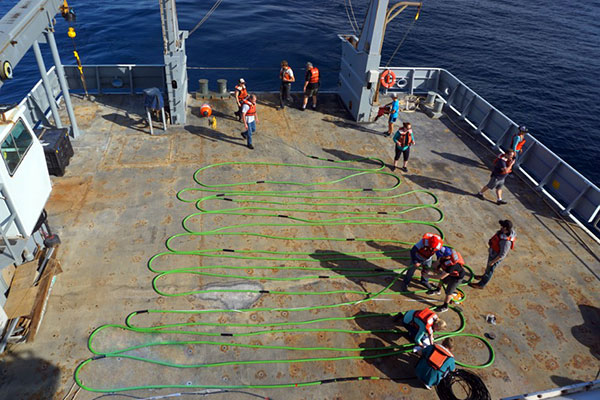
As part of the USGS studies of Los Angeles’ offshore hazards, students from the University of Washington, USGS scientists, and ship’s crew gather on the stern of the research vessel Thompson to haul in the seismic “streamer.” This green cable is full of hydrophones that record the sound generated from a minisparker. These are used together by scientists to help them map layers of sediment and rock beneath the seafloor between Catalina Island and San Clemente Island off Southern California, an area with two active faults. [Larger version]
Offshore earthquakes, undersea landslides, and tsunamis were among the hazards discussed during a USGS briefing for Congressman Adam Schiff’s staff in Southern California on June 9. Other topics included storms, landslides, wildfires, groundwater, volcanoes, onshore earthquakes,and early warning for debris flows. Geologist Jamie Conrad (Pacific Coastal and Marine Science Center) described USGS studies of the offshore hazards, highlighting recent seafloor mapping off Los Angeles, autonomous underwater vehicle (AUV) and remotely operated vehicle (ROV) surveys done with the Monterey Bay Aquarium Research Institute, and findings offshore the San Onofre Nuclear Generating Station. Congressman Schiff represents California’s 28th district in the Los Angeles area. The day-long briefing was held at the USGS Pasadena Office.
For more information, contact Jamie Conrad, jconrad@usgs.gov, 831-460-7407.
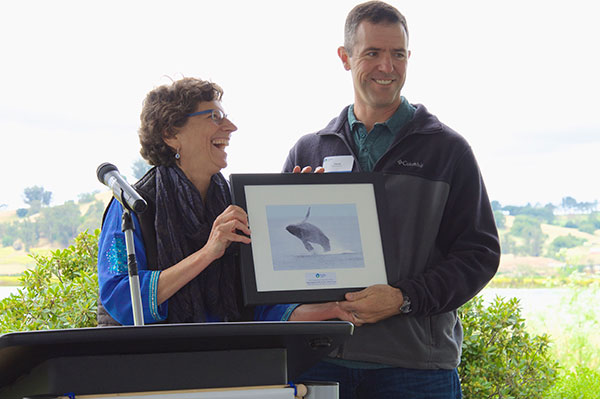
USGS Research Geologist Patrick Barnard accepting the award for the 2016 Outstanding Conservation Partner from Point Blue Conservation Science's President and CEO, Ellie Cohen, in Petaluma, CA, at the NGO's annual meeting.
Photo credit: Cathy Summa-Wolfe Photography
The USGS CoSMoS (Coastal Storm Modeling System) team has won the 2016 Point Blue Outstanding Partner Award from Point Blue Conservation Science. CoSMoS makes detailed predictions about coastal flooding due to both sea-level rise and storms driven by climate change. Thanks to a 7-year partnership with Point Blue, CoSMoS-based interactive flood maps for the San Francisco Bay region are available at Our Coast Our Future to aid resource and land-use managers planning for sea-level rise and storms. CoSMoS has been applied along additional stretches of the California coast in southern and northern California. The USGS CoSMoS team received the award at the Point Blue Annual Meeting on May 22 at Point Blue offices in Petaluma, California.
For more information, contact Patrick Barnard, pbarnard@usgs.gov, 831-460-7556.

Map of unconsolidated sediment thickness in Monterey Bay, excluding Monterey Canyon: There is a very large sediment deposit at the mouth of the Salinas River (blue and green colors), but otherwise the inner continental shelf is mostly underlain by bedrock (white) or has only a thin sediment cover (pink). The thickness of offshore sediment is an important factor in understanding and forecasting coastal erosion in this area, and in devising strategies for dealing with sea-level rise. Excerpt from USGS California State Waters Map Series — Offshore of Monterey Map Area, Sheet 9.
On May 31, 2016, scientists from the Pacific Coastal and Marine Science Center in Santa Cruz, California, spent two hours briefing Congressman Sam Farr (U.S. Representative for California central coast) on the center’s seafloor mapping and coastal-change-hazard studies. Congressman Farr requested a briefing after reading the USGS news release about newly published maps of the Monterey Bay seafloor. The briefing took place at the Monterey Bay National Marine Sanctuary (MBNMS) Main Office in Monterey, California. Bill Douros, Regional Director of West Coast Sanctuaries, and some MBNMS staff also attended.
Contact: Bob Rosenbauer, brosenbauer@usgs.gov, 831-460-7401.
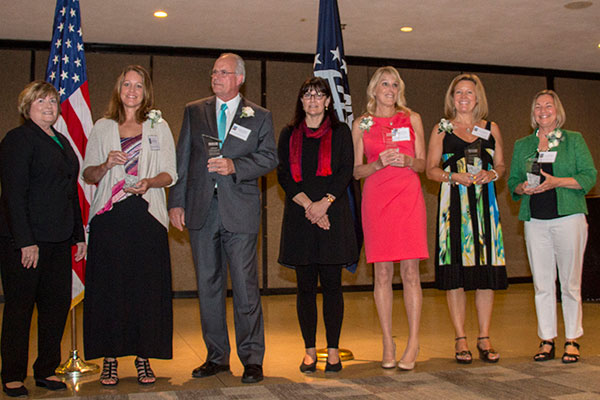
USGS Director Suzette Kimball and Kerry Rae, Chief of Staff from the USGS Office of the Assistant Secretary for Water and Science, with the CMGP web team members at the USGS Awards Ceremony in Reston, Virginia, on May 3rd, 2016. From left: Ms. Kimball, Jolene Gittens, Greg Miller, Ms. Rae, Andrea Toran, Laura Torresan, and Ann Tihansky.
The USGS Coastal and Marine Geology Program (CMGP) website, developed by Jolene Gittens, Greg Miller, Andrea Toran, Laura Torresan, and Ann Tihansky, won the Shoemaker Award for Communication Excellence in the internet product category.
The website content is designed to reach diverse internal and external audiences, who are curious about changes to the ocean and coasts. The site improves access to both current and historical coastal and ocean research information, including research projects, laboratory and technical capabilities, field activities, data, publications, news, outreach activities, and personnel information. The site allows users to browse research by theme or topic, as well as search by key words.
The website is a holistic presentation of USGS coastal and ocean science, and represents a successful collaboration of effort among the three science centers within CMGP. CMGP offices are located in Santa Cruz, California, St. Petersburg, Florida, and Woods Hole, Massachusetts.
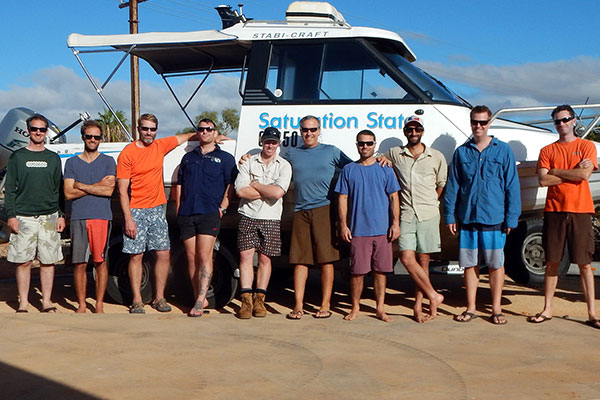 Collaborative Study in the Ningaloo Reef
Collaborative Study in the Ningaloo ReefUSGS Researchers from the Pacific Coastal and Marine Science Center in Santa Cruz, California, have just completed a collaborative effort with the University of Western Australia, at Jurabi in the Ningaloo UNESCO World Heritage Site in Western Australia. This was the largest, most intensive study of coral reef hydrodynamics, ever!
To lern more about this collaborative work, watch the video titled, “Breaking Down Reefs, Building Up Beaches”

Contact: Curt Storlazzi.
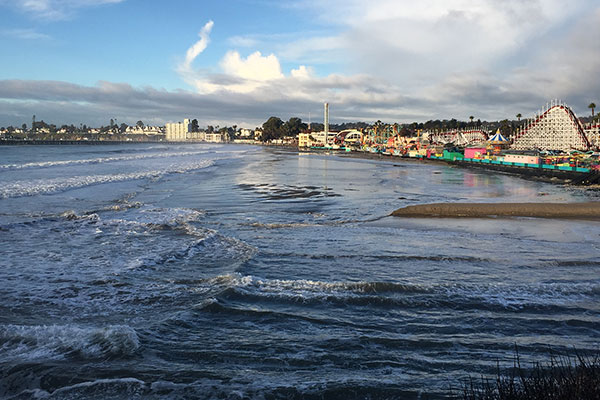
View across the San Lorenzo River eastward of the winter beach of the Santa Cruz Beach Boardwalk amusement park in Santa Cruz, California, January 7, 2016. Photo by Andy O'Neill, USGS. [Larger version]
USGS oceanographer and meteorologist Andy O’Neill was quoted in a Monterey Herald article about the 2016 Monterey Bay Economic Partnership Regional Economic Summit held April 26. O’Neill represented the USGS in an exhibit area where she spoke with attendees about how shifting beaches and rising sea level can affect certain sectors of the local economy. She explained that USGS data can be used to help plan for future contingencies.
Contact: Andy O’Neill, aoneill@usgs.gov, 831-460-7586.

SedPods, like this one at Kawaihae, Big Island, Hawaiʻi, are low-cost collection devices that mimic coral surfaces and permit accurate measurements of net sediment accumulation during the time they are on the seafloor. Photo by Curt Storlazzi, USGS.
Pollution that stems from actions on land, such as coastal development and agricultural runoff, can harm the health of coral reefs. That’s why the U.S. Coral Reef Task Force (USCRTF), of which the USGS is a co-science lead, established a Watershed Partnership Initiative in 2009. Now the USCRTF Watershed Partnership Initiative has published two new tools to help coastal resource managers reduce the impacts of land-based pollution on coral reefs. The first is a set of indicators and measurements for assessing coral community health, water quality, and sediment. USGS scientists developed the methods for monitoring sediment impacts. The second tool is a checklist to help watershed coordinators implement a successful watershed management plan. Learn more.
Contact: Curt Storlazzi.
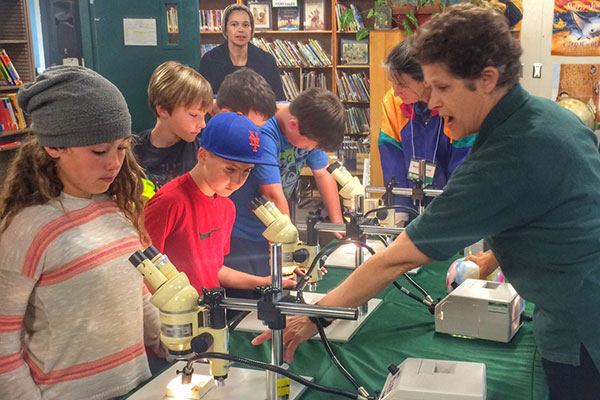
USGS researcher Mary McGann (right) instructs students on how to use the microscopes to view the shells of one-celled sea creatures called foraminifera.
A team from the USGS intrigued students at Mountain Elementary School in Soquel, California, with hands-on activities during the school’s April 22 Earth Day Celebration. First through fifth graders looked through microscopes to view the shells of one-celled sea creatures called foraminifera. The shells can tell scientists the age of the sediment in which forams are found, the ocean depths at which they lived, and what the seawater chemistry was like when they built their shells. Many students had never used a microscope and were astonished by the magnified views. The students learned topography by assembling clear plastic trays showing individual contour lines of Angel Island and Monterey Canyon. They also examined the stinky stomach contents regurgitated by albatrosses to see which of the undigested components are natural, like squid beaks, and which are unnatural, like toothbrushes, disposable lighters, and other plastic trash.
- Helen Gibbons
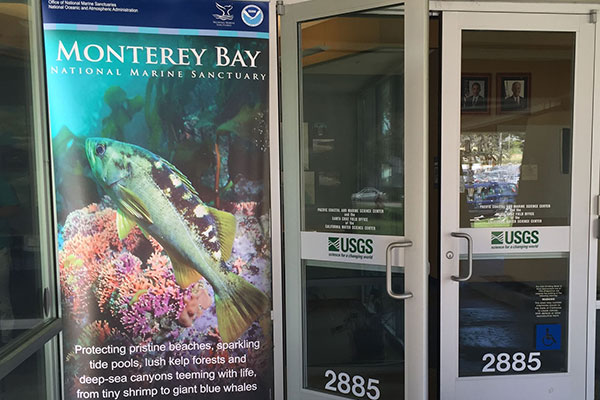
Banner of the Monterey Bay National Marine Sanctuary at the entrance to the USGS Pacific Coastal and Marine Science Center. Photo by Rex Sanders, USGS.
The Pacific Coastal and Marine Science Center in Santa Cruz, California, hosted a meeting of NOAA’s Monterey Bay National Marine Sanctuary Advisory Council on April 21, 2016. The advisory council, established by Federal law, assures continued public participation in the management of the sanctuary. The council meets bi-monthly in open sessions located throughout the almost 300-mile boundary of the Sanctuary. USGS is not a member of the advisory council, but works closely with the Sanctuary on many issues.
- Bob Rosenbauer
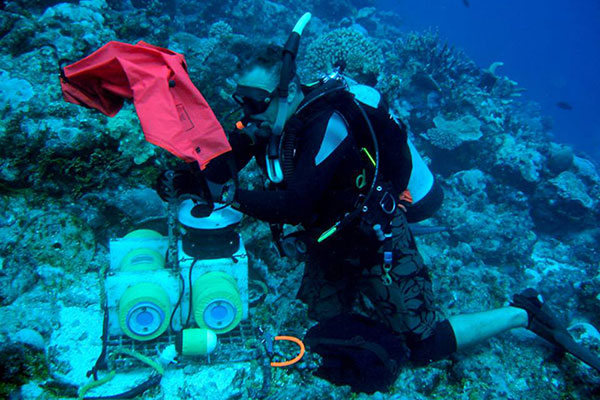
USGS oceanographer deploying an oceanographic instrument package in a patch of rubble on the coral reef off Roi-Namur Island, Kwajalein Atoll, in the Republic of the Marshall Islands.
In a recent report, the U.S. Geological Survey (USGS) took first place for science research credibility among ocean resource managers and interest group leaders. The study authors asked several hundred people to rank the research reputations of 12 government agencies and organization types on “marine resource management and environmental policy issues.” USGS also took second place overall (behind public research universities) for scientific research credibility. The article, published in Ocean & Coastal Management, analyzed 570 surveys returned by scientists, managers, and interest group leaders. The study also found that the top three indicators of credible scientists were “quality of the methodology used in their scientific research,” “scientific data and information they generate in their research,” and “experience and knowledge of the management of marine resources.” USGS has a long history of high-quality research methods and data sharing, combined with experienced and knowledgeable ocean research staff.
Contact: Rex Sanders.

USGS oceanographer Curt Storlazzi deploying an oceanographic instrument package on the reef flat off Roi-Namur Island, Kwajalein Atoll, in the Republic of the Marshall Islands (RMI).
On the morning of May 3, 2016, USGS oceanographer Curt Storlazzi (Pacific Coastal and Marine Science Center) briefed the Department of Defense on coral reefs and climate change in the Pacific Ocean. That afternoon, he briefed the Department of the Interior and its Office of Insular Affairs. Storlazzi leads the USGS Coral Reef Project. Recent results show that climate change may reduce the ability of coral reefs to protect tropical islands against wave attack, erosion, and salinization of drinking-water resources (read the article). Storlazzi’s briefings described these and other findings, including the likely impacts of sea-level rise and climate change on Pacific atolls.
Contact: Curt Storlazzi.

Curt Storlazzi free dives to attach a temperature sensor along the reefs in Kauai. USGS wants to understand the local oceanography when investigating why disease has struck Kauai’s corals.
A new video, “Exploring Causes of Coral Disease,” follows USGS researchers as they investigate potential causes of black band disease affecting corals on the Hawaiian island of Kauai. In spring 2015, scientists from the Pacific Coastal and Marine Science Center (Santa Cruz, California) and the St. Petersburg Coastal and Marine Science Center (St. Petersburg, Florida) ran initial surveys to check water temperature, salinity, and whether water running off the land may be affecting coral health. An expanded team will return this summer for more in-depth work. Healthy reefs protect the shore from wave damage, provide shelter for important fish species, and are vital to tourism.
For more information, contact Curt Storlazzi, cstorlazzi@usgs.gov, 831-460-7521; or Chris Kellogg, ckellogg@usgs.gov, 727-502-8128.

Photograph of the San Mateo County coastline on January 17, 2016, during a very high tide and storm event; photo by Laura Zink Torresan.
USGS research geologist Patrick Barnard (Pacific Coastal and Marine Science Center) was interviewed on April 5, 2016, by reporter Carina Woudenberg of the Half Moon Bay Review for a story about coastal erosion. Woudenberg’s article, “The Crumbling Coastside”, includes quotes from Barnard on rising coastal erosion rates in San Mateo County and factors that make the county’s coastline the most rapidly eroding section in California.
For more information, contact Patrick Barnard, pbarnard@usgs.gov, 831-460-7556.
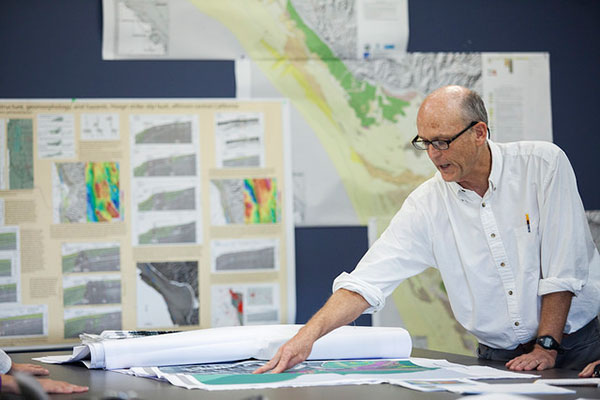
Geophysicist Samuel Johnson checks out the new maps at the USGS Marine Geology Mapping center, Thursday, June 11, 2015, in Santa Cruz, California.
New seafloor maps from Monterey Bay north to Pigeon Point are the subject of a front-page article in the Santa Cruz Sentinel published April 9, 2016. The latest maps released by the California Seafloor Mapping Program reveal complex details of the ocean floor, including new seafloor faults and unexpected patches of bare bedrock. The short faults could be sources of small earthquakes, and the bare patches suggest that the region has less offshore sand than previously thought for replenishing sand eroded from beaches. Read the article, and learn more about the maps in a USGS news release.
For more information, contact Sam Johnson, sjohnson@usgs.gov, 831-460-7546.
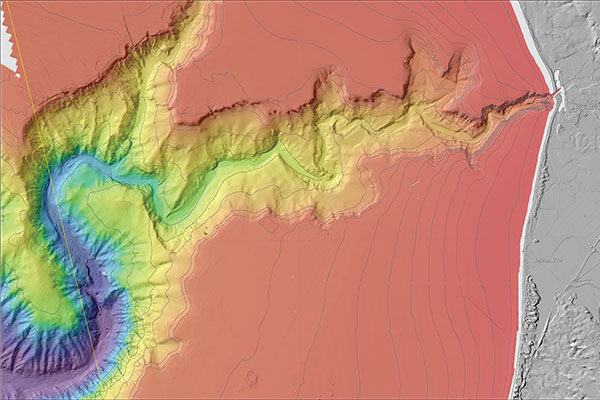
Bathymetry of Monterey Canyon and the Soquel Canyon tributary: Monterey Canyon is one of the largest and deepest submarine canyons in the world, reaching depths of 1,520 m (5,000 ft) at the State Waters boundary. Upwelling through the canyon provides nutrients for the highly productive marine ecosystem of Monterey Bay. Excerpt from USGS California State Waters Map Series—Monterey Canyon and Vicinity Map Area, Sheet 1.
March 29th, 2016
Six new sets of maps reveal the diverse and complex range of seafloor habitats along 130 kilometers (80 miles) of the central California coast from the Monterey Peninsula north to Pigeon Point. The publicly available maps can be used by a large stakeholder community to understand and manage California’s vast and valuable marine resources.
Read the rest of the USGS Newsroom State/Local News Release, posted March 29th, 2016.
KION-TV in Salinas, California, interviewed USGS research geologist Sam Johnson about new California Seafloor Mapping Program (CSMP) maps for the Monterey Bay region. Several maps highlight the San Gregorio fault, which is capable of a magnitude 7 earthquake. CSMP is a cooperative program to create comprehensive coastal and marine bathymetric, geologic, and habitat base maps for all of California’s State Waters. CSMP has released more than 230 map sheets with a digital database, covering 30 percent of the coast, with more maps under development. The 1:35 video is online.
For more information, contact Sam Johnson, sjohnson@usgs.gov, 831-460-7546.
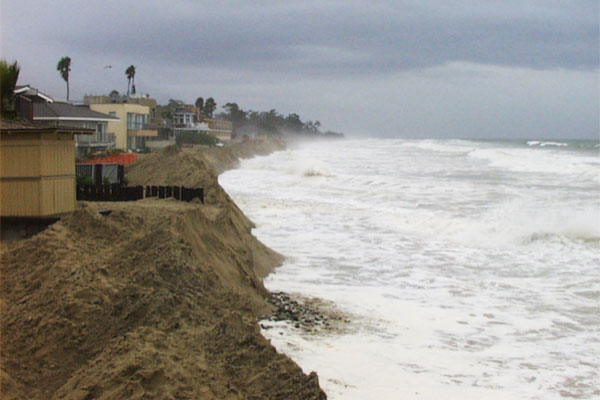
Photo of extreme event threatening erosion of the coast in Carpenteria, CA.
Reporter Aaron Orlowski from the newspaper Orange County Register interviewed USGS scientists Patrick Barnard and Patrick Limber for a potential story on sea level rise in southern California. Barnard leads the Coastal Storm Monitoring System (CoSMoS) project, which predicts coastal flooding and cliff erosion based on climate change forecasts and different storm scenarios. Limber is the project’s expert on cliff erosion. Coastal resource managers in southern California are using CoSMoS forecasts based on zero sea level rise to prepare for El Niño storm damage.
For more information, contact Patrick Barnard, pbarnard@usgs.gov, 831-460-7556, or Patrick Limber, plimber@usgs.gov, 831-460-7548.
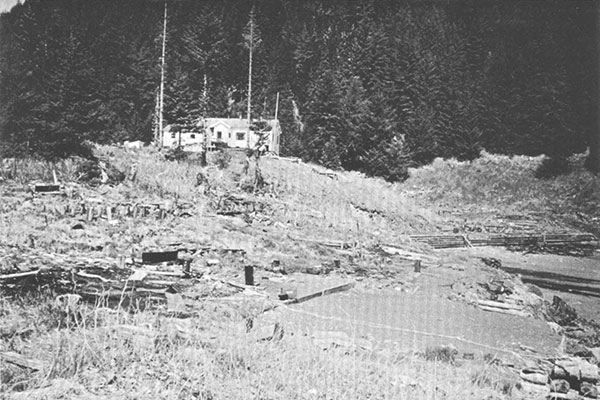
Main part of the Chenega village site in Alaska. Pilings in the ground mark the former locations of homes swept away by tsunami waves. Schoolhouse on high ground was undamaged. Photograph taken 1964.
Minutes after the 1964 magnitude-9.2 Great Alaska Earthquake (see “The Great Alaska Earthquake and Tsunami of March 27, 1964”), a series of tsunami waves swept through the village of Chenega in Prince William Sound, destroying all but two of the buildings and killing 23 of the 75 inhabitants. Fifty years later, detailed seafloor images revealed the likely cause of the tsunami: a large set of underwater landslides. USGS scientists and their colleagues from Boise State University and the Alaska Department of Fish and Game collected the images while mapping the seafloor in May 2014. Their findings, published in January 2016 in the journal Earth and Planetary Science Letters, underscore the tsunami hazard that submarine landslides can pose in fjords around the world where communities and ports are commonly located.
Read the entire Sound Waves newsletter article.
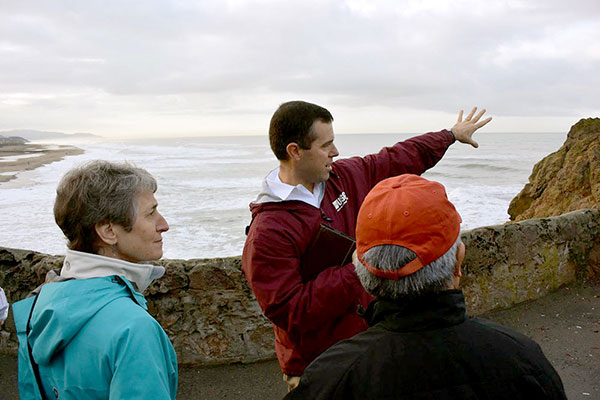
USGS geologist Patrick Barnard tells Secretary of the Interior Sally Jewell and San Francisco Mayor Ed Lee about the coastal hazards facing Ocean Beach. Photo taken December 18, 2014 by Tami Heileman, U.S. Department of the Interior.
Researchers with the USGS Coastal and Marine Geology Program study coastal hazards like beach erosion and cliff collapse at many locations over years and decades. By comparing conditions before, during, and after this year’s very strong El Niño, these scientists hope to improve forecasts of coastal changes during future events.
Read the entire Sound Waves newsletter article.

This photograph is of the Puget Sound seafloor and shows a sandy area with partial hydroid and algae cover occupied by sea stars and small filter feeding worms. This image was collected as part of USGS efforts to help with rockfish recovery in the Puget Sound. Scientists are mapping their ecosystem and habitat to understand population distribution.
The USGS has completed the second phase of releasing thousands of photos and videos of the seafloor and coastline through their Coastal and Marine Video and Photography Portal.
Most of these marine and coastal scenes have never been seen before or mapped at this level of detail. A more accurate perspective of these areas helps coastal managers make important decisions that range from protecting habitats to understanding hazards and managing land use.
Read the entire Sound Waves newsletter article.
“Atoms for Peace” is the mission of the International Atomic Energy Agency (IAEA), where USGS research oceanographer Peter Swarzenski will take a post as head of the Radioecology Laboratory in Monaco.
Read the entire Sound Waves newsletter article.
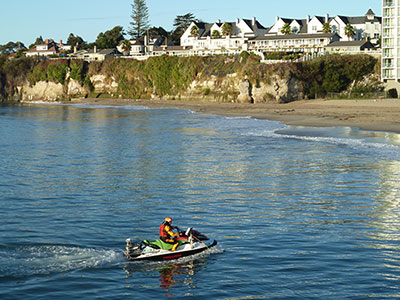
USGS scientist uses a personal watercraft fitted with GPS and an echo sounder to survey the seafloor off Santa Cruz, California. Recurring surveys monitor sand movement to improve predictions of coastal change. Photograph taken October 20, 2014, by Andrew Stevens, USGS PCMSC.
Research geologists Patrick Barnard and Jon Warrick and oceanographer Dan Hoover (all from the Pacific Coastal and Marine Science Center) were interviewed for a story about coastal erosion that appeared March 2, 2016, in the Good Times, a weekly paper in Santa Cruz, California. “Living on the Edge” describes ongoing USGS studies of coastal erosion and sand movement along the coast from San Francisco to Monterey. For more information, contact project leads Patrick Barnard (pbarnard@usgs.gov, 831-460-7556) and Jon Warrick (jwarrick@usgs.gov, 831-460-7569).
Scientists from the USGS Coastal and Marine Geology program plan to present 36 talks or posters at the 2016 Ocean Sciences Meeting, February 21 to 26, in New Orleans. Presentation topics range from forecasts of vanishing California beaches to marshland carbon sequestration in Chesapeake Bay. The conference, held every two years, is a joint meeting of three scientific societies: American Geophysical Union (http://agu.org), Association for the Sciences of Limnology and Oceanography (http://aslo.org), and The Oceanography Society (http://tos.org).
| Takeaway message | Presentation number, title, and link | Presenters |
|---|---|---|
| Stable wetlands sequester carbon, unstable wetlands lose carbon in Chesapeake Bay | EC14B-0967: Quantifying organic matter fluxes in an era of wetland instability | Neil Ganju |
| Cape Cod salt marshes keep up with sea level rise | EC14B-0976: Carbon Burial in Salt Marshes: Impacts of Sea Level Rise and Marsh Restoration | Meagan Gonneea |
| Healthy seagrass meadows in Maryland could reduce wave action by 40 percent | EC14C-1015: Modeling the Hydrodynamic Effects of Seagrass Meadows in a Shallow, Back-barrier Estuary | Alexis Beudin |
| Southern California beach cliffs could erode much faster as ocean rises | MG14A-1924: Forecasting sea cliff retreat in Southern California using process-based models and artificial neural networks | Patrick Limber |
| USGS researchers to receive NOPP Excellence in Partnering Award | 1:00 - 2:30 PM, Room 223: National Oceanographic Partnership Program--2015 Excellence in Partnering Awards Ceremony | Principal Investigators: Amanda Demopoulos, Cheryl Morrison, Nancy Prouty, Christina Kellogg |
| Rising oceans lead to more big waves washing over Pacific islands | EC23A-02: Wave Transformation over a Fringing Coral Reef and the Importance of Low-Frequency Waves and Offshore Water Levels to Runup and Island Overtopping | Olivia Cheriton |
| One in four Southern California beaches could vanish by 2100 | MG23A-05: Development and Application of a Long-term Shoreline Change Model for Assessing Climate Change Impacts | Sean Vitousek |
| Coral reefs wonÕt protect Pacific islands from sea level rise flooding | EC24C-1121: The influence of corals, coral reef morphology, and climate change on waves and wave-driven water levels along reef-lined coasts | Curt Stolazzi |
| Uneven effects of El Ni–o and climate change on Pacific Ocean coastlines | EC31A-01: Recent Pacific Ocean basin coastal response to inter-annual climate variability with implications for future climate change impacts | Patrick Barnard |
| Artificial dunes in Louisiana vanish quickly but help anyway | MG44B-1992: Morphological controls on barrier-island response and recovery following natural and anthropogenic perturbations, northern Chandeleur Islands, Louisiana | Julie Bernier |

Left to right: CMGP web design team Laura Torresan, Jolene Gittens, Andrea Toran, Ann Tihansky (team lead), and Greg Miller (web developer/programmer).
The USGS Coastal and Marine Geology Program website won the USGS 2015 Shoemaker Award for Communication Product Excellence in the Internet Product category. This award recognizes products that effectively convey complex scientific concepts to non-science audiences. The re-designed website offers science, data, and news from the three Coastal and Marine Geology Science Centers. The design team — coordinator Ann Tihansky (Coastal and Marine Geology Program), Jolene Gittens (St. Petersburg Coastal and Marine Science Center), Greg Miller (Woods Hole Coastal and Marine Science Center [WHCMSC]), Andrea Toran (WHCMSC), and Laura Torresan (Pacific Coastal and Marine Science Center [PCMSC]) — will be celebrated at the USGS Honor Awards ceremony in Reston, Virginia, on May 3. Laura Torresan also was on the team that won a 1998 Shoemaker Award for what is now the PCMSC web site.
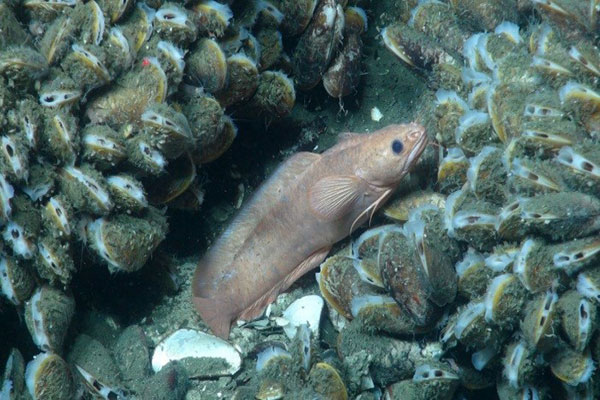
Methanotrophic mussels with rockling fish. Image Credit: Atlantic Canyons: Pathways to the Abyss, BOEM/NOAA OER/USGS.
USGS scientists and collaborators from more than a dozen research institutions will receive the National Oceanographic Partnership Program (NOPP) 2015 Excellence in Partnering Award on February 23, 2016, at the Ocean Sciences Meeting in New Orleans. The award recognizes the research team’s Atlantic Canyons: Pathways to the Abyss project. The team received another major award in January 2014, when Secretary of the Interior Sally Jewell presented them with the DOI Partners in Conservation Award. USGS scientists on the team studied underwater canyon geology, oceanography, ecology, and biology.
For more information, contact principal investigators Amanda Demopoulos (project chief), ademopoulos@usgs.gov, 352-264-3490;
Nancy Prouty, nprouty@usgs.gov, 831-460- 7526;
Cheryl Morrison, cmorrison@usgs.gov, 304-724-4464; or
Christina Kellogg, ckellogg@usgs.gov, 727-502-8128.
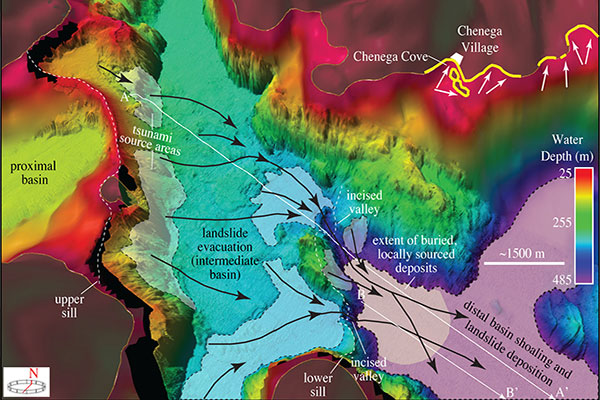
3-D perspective view of shaded relief bathymetry offshore Chenega village. Shaded patches of seafloor depict areas that experienced dramatic changes in water depth between 1957 and 2014. Read more in the USGS Newsroom.
Minutes after the 1964 magnitude-9.2 Great Alaska Earthquake began shaking, a series of tsunami waves swept through the village of Chenega in Prince William Sound, destroying all but two of the buildings and killing 23 of the 75 inhabitants. Fifty years later, scientists from the U.S. Geological Survey revealed the likely cause of the tsunami, a large set of underwater landslides. The scientists used detailed seafloor images not only clear up a decades-old mystery, but also underscore the tsunami hazard that submarine landslides can pose in fjords around the world where communities and ports are commonly located.
Read the entire News Release from February 1, 2016.
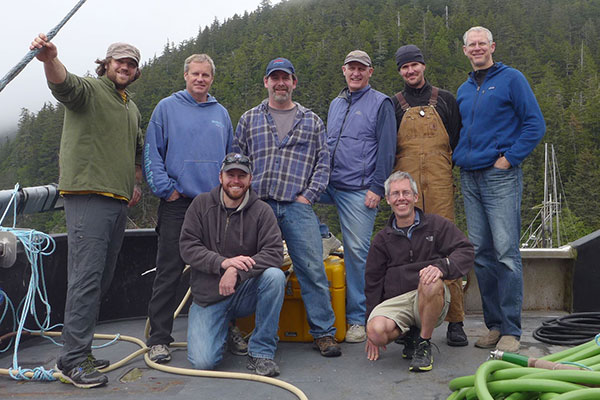
Survey team on fantail of research vessel (R/V) Solstice: James Weise (Alaska Department of Fish and Game [ADFG]), Pete Dartnell (USGS), Dave Anderson (ADFG), Rob Wyland (USGS), John Crowfts (ADFG), and Peter Haeussler (USGS). Kneeling, left to right: Danny Brothers (USGS) and Gerry Hatcher (USGS). [Read more]
A team of USGS scientists—Danny Brothers, Pete Dartnell, Gerry Hatcher, and Rob Wyland from the Pacific Coastal and Marine Science Center and Peter Haeussler from the Alaska Science Center (see photo, above)—led multibeam bathymetry and multichannel seismic-reflection surveys along the northernmost offshore section of the Queen Charlotte-Fairweather fault, between Cross Sound and Icy Point.
Read the entire article in the Sound Waves newsletter.
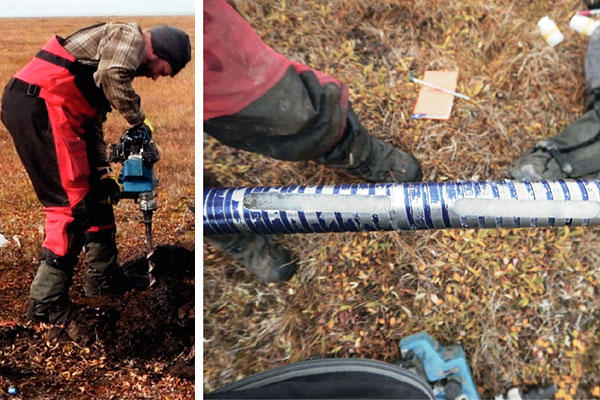
Left, Cordell Johnson drilling and coring the interior of the bluff to ground-truth geophysical methods. Right, a core section filled mostly with ice. [Read more]
In September 2015, scientists from the U.S. Geological Survey (USGS) and the University of California, Santa Cruz (UCSC) surveyed rapidly eroding permafrost bluffs on Barter Island, a remnant of low-elevation tundra on Alaska’s Arctic coast. Warming air and sea temperatures in the Arctic are leading to longer periods of permafrost thaw and ice-free conditions during the summer months, which can weaken the coastal bluffs and increase their vulnerability to storm surge and wave impacts. The 2015 survey is part of a long-term effort to document seasonal to decadal coastal-bluff change on the island’s north coast.
Read the entire article in the Sound Waves newsletter.

Pete Dal Ferro deploying the bubbler system from an inflatable vessel. [Read more]
In November 2015, scientists from the U.S. Geological Survey (USGS) conducted an experiment using in-house equipment to image artificially created gas plumes offshore of Santa Cruz, California. The experiment is part of our preparation for a 2016 survey of California’s Santa Barbara Basin, where we plan to map the seafloor, image sediment layers beneath the seafloor, and detect and map seafloor seeps. One of the goals of the upcoming Santa Barbara Basin study is to better understand the relationship between sub-seafloor fluid flow, faults, and submarine landslides.
Read the entire article in the Sound Waves newsletter.
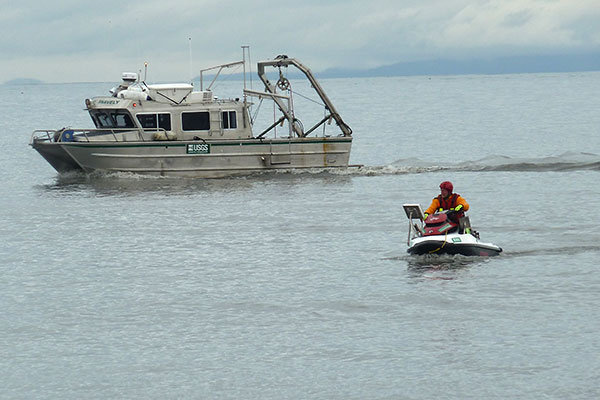
USGS research vessel Parke Sanvely and USGS scientist operating a personal watercraft equipped with echosounders used for mapping the nearshore region. [Larger version]
Scientists from the Pacific Coastal and Marine Science Center plan to survey the mouth, beach, and nearby seafloor of the Elwha River in Washington, February 15–19, 2016. The survey will continue to document changes triggered by the 2011–2014 removal of two large dams upstream. Scientists on the research vessel Parke Snavely will map the seafloor using swath sonar. Others, on smaller vessels, will map close to shore and about 1 kilometer up the river using echosounders. Scientists onshore will survey the beach using backpack GPS receivers. A crew on the research vessel Frontier will collect sediment samples to measure grain-size. Similar surveys, conducted regularly since 2004, recorded major changes to the area.
Visit the web page USGS Science to Support the Elwha River Restoration Project.
For more information, contact
Jon Warrick, jwarrick@usgs.gov, 831-460-7569, or
Andrew Stevens, astevens@usgs.gov, 831-460-7424.
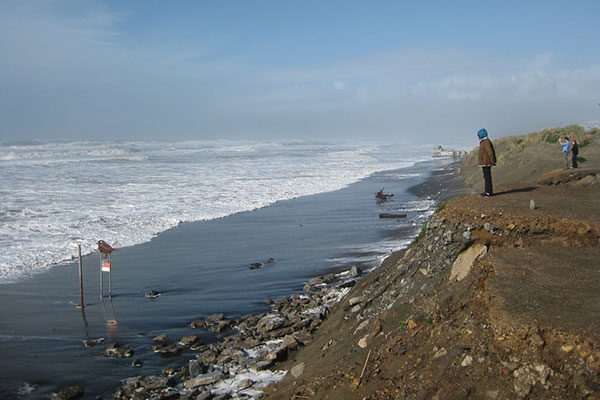
Severe coastal bluff erosion, along the southern end of Ocean Beach, San Francisco, California. This storm damage occurred during the 2009-2010 El Niño, which, on average, eroded the shoreline 55 meters that winter. Photo taken on January 20, 2010 by Jeff Hansen, USGS.
Although the U.S. Geological Survey doesn’t directly study or forecast the weather (our sister agency, NOAA, and its National Weather Service do), the USGS studies and documents the effects and impacts of long-term climate changes and weather phenomena across the U.S. and globally. In particular, the USGS monitors streamflow, floods, landslides, erosion, sea-level rise, and many other earth processes that affect communities and that are often affected by El Niño weather patterns. USGS closely monitors these effects to assist the NWS in its responsibilities for hazard warnings and to assist communities across the country in their preparation, response, and recovery activities.
Learn more about USGS El Niño studies in this article featured as a Top Story in the USGS Newsroom.
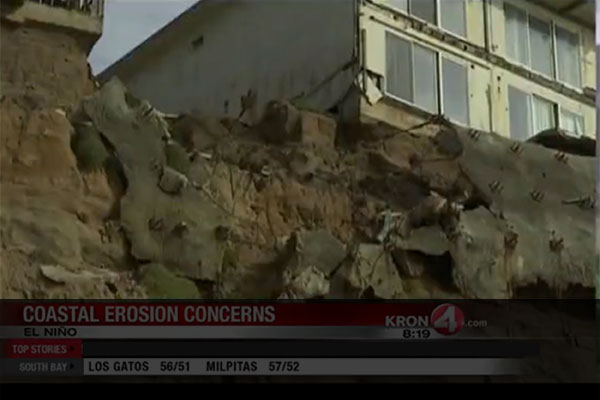 USGS oceanographer in KRON4-TV story about possible beach-cliff erosion from El Niño storms in San Francisco, California
USGS oceanographer in KRON4-TV story about possible beach-cliff erosion from El Niño storms in San Francisco, CaliforniaUSGS oceanographer Dan Hoover (Pacific Coastal and Marine Science Center) was interviewed by Charles Clifford of KRON4-TV for a story about coastal-cliff erosion that could occur on beaches in and near San Francisco, California, during El Niño storms this winter. Hoover met Clifford on January 12, 2016, at Mussel Rock Park in Daly City. He explained that wave energy typically increases by about 20 percent during an El Niño winter, and storm waves combined with high tides could reach the base of cliffs and cause erosion. He noted that bluffs on different beaches differ in the geology and hydrology that affect how they will fail, making them challenging to study. The interview, broadcast that night, can be viewed at:
http://kron4.com/2016/01/12/video-powerful-el-nino-storms-could-lead-to-erosion/.
For more information, contact Dan Hoover, dhoover@usgs.gov, 831-460-7544.
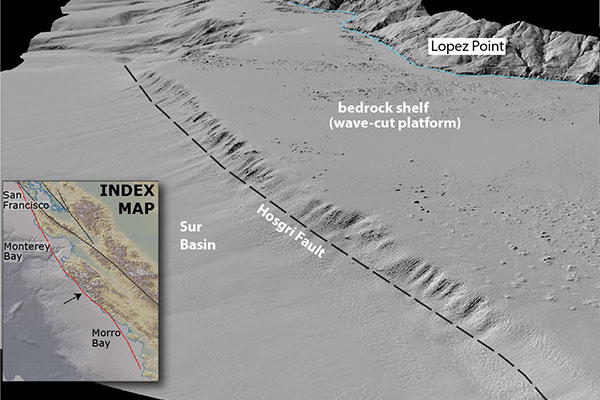
Perspective view offshore of the Big Sur coast. The steep slope beside the Hosgri fault results from uplift along the fault, which is part of the strike-slip fault system that forms the boundary in California between the Pacific and North American tectonic plates.
Sam Johnson of the Pacific Coastal and Marine Science Center and David Schwartz and Lind Gee of the Earthquake Science Center were interviewed January 13, 2016, by KION, the CBS TV affiliate out of Salinas, California, for a program on earthquake hazards in central California. Johnson was interviewed about offshore faults and seafloor imaging. Schwartz discussed earthquake probabilities and forecasting and how a large earthquake could impact the state and the central coast. Gee described how the USGS monitors earthquakes in California. The story aired February 7 after the Super Bowl.
For more information, contact Sam Johnson, sjohnson@usgs.gov, 831-460-7546.

USGS scientist deploying seismic equipment from Research Vessel Parke Snavely in San Pablo Bay, CA.
New USGS mapping shows that two earthquake faults, the Hayward and Rodgers Creek faults, may be directly connected deep beneath San Pablo Bay, a northern extension of San Francisco Bay, California. Such a connection could increase total fault-rupture length and resultant shaking during an earthquake. USGS research geophysicist Janet Watt, who led the mapping effort, was interviewed by San Francisco Chronicle science editor David Perlman on December 15 at the American Geophysical Union Fall Meeting, where she presented the new findings. Perlman’s article, published December 31st, led to additional interviews of Watt and her colleagues by CBS/KPIX television, KCBS radio, the Marin Independent Journal, KRON-4 television, Talk 910 AM radio, USA Radio Network News, Univision, KTSF Channel 26, the Contra Costa Times, and the San Jose Mercury News.
For more information, contact Janet Watt, jwatt@usgs.gov, 831-460-7565.
Stephanie Ross (USGS Pacific Coastal and Marine Science Center and Science Applications for Risk Reduction [SAFRR]) was the USGS coordinator for a National Tsunami Hazard Mitigation Program (NTHMP) workshop, February 1-2, 2016, in Boulder, Colorado. NOAA’s NTHMP provides a customer-based, grass-roots approach to tsunami-hazard assessment and mitigation. The workshop’s goal was to improve collaboration between NTHMP and USGS to provide better tsunami-preparedness products for coastal communities. Topics included: identification and cataloging of tsunami sources (potential earthquakes and landslides); standardized tsunami sources for scenario calculations; and tsunami-vulnerability assessments. About 30 USGS participants and 30 participants from other federal agencies and tsunami-vulnerable states and territories attended the workshop, scheduled just before the NTHMP annual meeting. Stephanie Ross and Nate Wood (USGS Western Geographic Science Center) are the USGS representatives to NTHMP.
For more information see http://nws.weather.gov/nthmp/2016annualmeeting/ or contact Stephanie Ross, sross@usgs.gov, 650-329-5326.
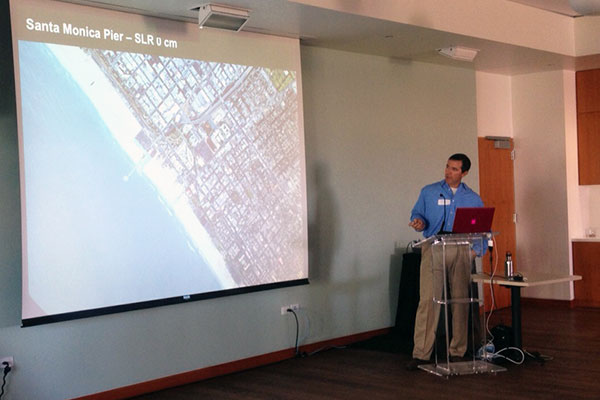
Patrick Barnard presents the initial results from the new CoSMoS 3.0 model for Southern California. Photo by Holly Rindge, USC Sea Grant.
On January 21, 2016, USGS research geologist Patrick Barnard discussed initial hazard maps that show potential flooding in the Orange County region from a 100-year storm combined with four scenarios of sea-level rise. The maps are generated by the latest version of the Coastal Storm Modeling System (CoSMoS 3.0), a USGS-led modeling system that projects coastal flooding and erosion due to both sea-level rise and storms driven by climate change. Many California agencies are using CoSMoS data to plan for coastal impacts from El Niño storms. The webinar “Sub-Regional Coastal Storm Modeling Results: Orange County” was broadcast live on January 21 and is now available as an archived recording.
For more information, visit the CoSMoS website, read more on the USC Sea Grant web page, or contact Patrick Barnard, pbarnard@usgs.gov, 831-460-7556.
Back to the top of the page.